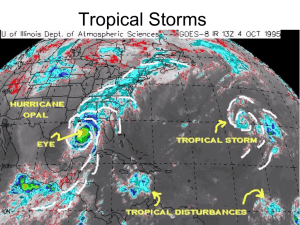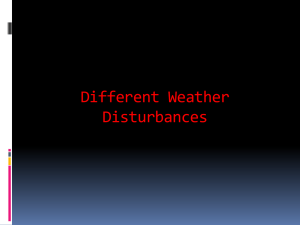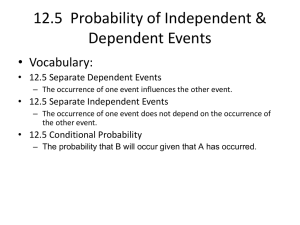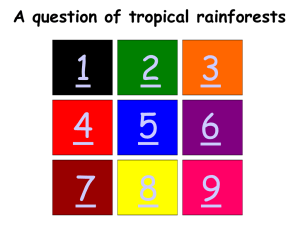RSMC Proposed Action Items
advertisement
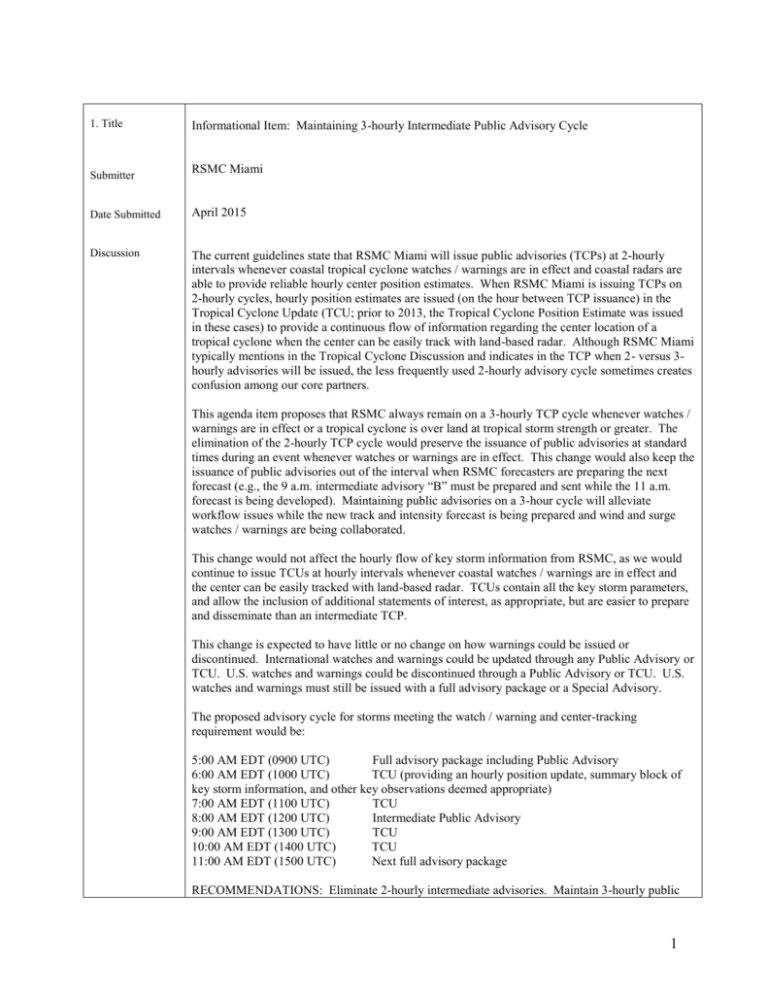
1. Title Submitter Informational Item: Maintaining 3-hourly Intermediate Public Advisory Cycle RSMC Miami Date Submitted April 2015 Discussion The current guidelines state that RSMC Miami will issue public advisories (TCPs) at 2-hourly intervals whenever coastal tropical cyclone watches / warnings are in effect and coastal radars are able to provide reliable hourly center position estimates. When RSMC Miami is issuing TCPs on 2-hourly cycles, hourly position estimates are issued (on the hour between TCP issuance) in the Tropical Cyclone Update (TCU; prior to 2013, the Tropical Cyclone Position Estimate was issued in these cases) to provide a continuous flow of information regarding the center location of a tropical cyclone when the center can be easily track with land-based radar. Although RSMC Miami typically mentions in the Tropical Cyclone Discussion and indicates in the TCP when 2- versus 3hourly advisories will be issued, the less frequently used 2-hourly advisory cycle sometimes creates confusion among our core partners. This agenda item proposes that RSMC always remain on a 3-hourly TCP cycle whenever watches / warnings are in effect or a tropical cyclone is over land at tropical storm strength or greater. The elimination of the 2-hourly TCP cycle would preserve the issuance of public advisories at standard times during an event whenever watches or warnings are in effect. This change would also keep the issuance of public advisories out of the interval when RSMC forecasters are preparing the next forecast (e.g., the 9 a.m. intermediate advisory “B” must be prepared and sent while the 11 a.m. forecast is being developed). Maintaining public advisories on a 3-hour cycle will alleviate workflow issues while the new track and intensity forecast is being prepared and wind and surge watches / warnings are being collaborated. This change would not affect the hourly flow of key storm information from RSMC, as we would continue to issue TCUs at hourly intervals whenever coastal watches / warnings are in effect and the center can be easily tracked with land-based radar. TCUs contain all the key storm parameters, and allow the inclusion of additional statements of interest, as appropriate, but are easier to prepare and disseminate than an intermediate TCP. This change is expected to have little or no change on how warnings could be issued or discontinued. International watches and warnings could be updated through any Public Advisory or TCU. U.S. watches and warnings could be discontinued through a Public Advisory or TCU. U.S. watches and warnings must still be issued with a full advisory package or a Special Advisory. The proposed advisory cycle for storms meeting the watch / warning and center-tracking requirement would be: 5:00 AM EDT (0900 UTC) Full advisory package including Public Advisory 6:00 AM EDT (1000 UTC) TCU (providing an hourly position update, summary block of key storm information, and other key observations deemed appropriate) 7:00 AM EDT (1100 UTC) TCU 8:00 AM EDT (1200 UTC) Intermediate Public Advisory 9:00 AM EDT (1300 UTC) TCU 10:00 AM EDT (1400 UTC) TCU 11:00 AM EDT (1500 UTC) Next full advisory package RECOMMENDATIONS: Eliminate 2-hourly intermediate advisories. Maintain 3-hourly public 1 Action advisory cycle whenever coastal watches or warnings are in effect or a tropical cyclone is over land at tropical storm strength or greater. When coastal watches or warnings are in effect and the center can be easily tracked with land-based radar, RSMC Miami would issue hourly TCUs in between 3hourly Public Advisories to provide a continuous flow of information regarding the center location of a tropical cyclone. These TCUs would contain a summary block of key storm information, and other key observations as deemed appropriate. Provide appropriate public notices. Item ACTION: Recommendations accepted. Forward to WMO RA-IV. 2. Title: Name Replacement Submitter: RSMC Miami Date Submitted: April 2015 Discussion: Given the relevance of the name Isis in the world current affairs, RSMC Miami recommends the replacement of the name Isis from the 2016 Eastern North Pacific list by Ilene, Iola or Ivette. Action Forward to WMO RA-IV HC Committee for consideration. 3. Title Informational Item: Change Time Zones for Eastern Pacific Tropical Cyclone Public Advisory (TCP) and Tropical Cyclone Discussion (TCD) Submitter: RSMC Miami Date Submitted: April 2015 Discussion: Currently, the eastern Pacific Public Advisory is always issued in the Pacific Time Zone; a holdover from the days of the eastern Pacific advisories coming out of Redwood City, CA. We’ve received feedback that this is confusing to the general public since almost all of Mexico is not in the Pacific Time Zone (see map next page). This problem was highlighted in Odile when some people in Cabo San Lucas (in Mountain Daylight Time) were confused about the landfall time of the cyclone - a situation that endangers public safety. Clearly, this problem is even worse when a cyclone is farther east, with most of the rest of Mexico in Central Time. The Mexican Weather Service enthusiastically supports this change. Action Forward to WMO RAIV 2 4. Title Informational Item: Use of Mixed Case for Tropical Cyclone Public Advisories, Tropical Cyclone Updates, and Monthly Tropical Cyclone Summaries Submitter: RSMC Miami Date: April 2015 Discussion: In 2014, RSMC Miami successfully transitioned from all capital letters to mixed case for our Tropical Weather Outlooks and Tropical Cyclone Discussions. This has been very well received by our customers and there have been no reported issues in receiving the products with mixed case. RSMC issues other tropical cyclone products that have a significant component of text in sentence / paragraph form. Action: RECOMMENDATIONS: 1. Transition the following additional products to mixed case as soon as resources permit: Tropical Cyclone Public Advisory (TCP), Tropical Cyclone Update (TCU), and Monthly Tropical Cyclone Weather Summary (TWS). Examples of each product are given on the next few pages. 2. RSMC determine whether these products can be updated for the 2015 season, and if so, issue appropriate public notices. Tropical Cyclone Public Advisory (TCP) ZCZC MIATCPAT1 ALL TTAA00 KNHC DDHHMM BULLETIN TROPICAL DEPRESSION ONE ADVISORY NUMBER 1 NWS NATIONAL HURRICANE CENTER MIAMI FL AL012014 1100 PM EDT MON JUN 30 2014 ...TROPICAL DEPRESSION FORMS EAST OF FLORIDA... ...TROPICAL STORM WATCH ISSUED FOR THE COAST OF EAST-CENTRAL 3 FLORIDA... SUMMARY OF 1100 PM EDT...0300 UTC...INFORMATION -------------------------------------------------------------------------------LOCATION...27.6N 79.1W ABOUT 105 MI...170 KM ESE OF CAPE CANAVERAL FLORIDA ABOUT 210 MI...335 KM NNW OF THE NORTHWESTERN BAHAMAS MAXIMUM SUSTAINED WINDS...35 MPH...55 KM/H PRESENT MOVEMENT...SW OR 225 DEGREES AT 2 MPH...4 KM/H MINIMUM CENTRAL PRESSURE...1009 MB...29.80 INCHES WATCHES AND WARNINGS ---------------------------------------CHANGES WITH THIS ADVISORY: A Tropical Storm Watch has been issued for the east coast of Florida from Fort Pierce northward to just south of Flagler Beach. SUMMARY OF WATCHES AND WARNINGS IN EFFECT: A Tropical Storm Watch is in effect for... * East coast of Florida from Fort Pierce to Flagler Beach A Tropical Storm Watch means that tropical storm conditions are possible within the watch area, in this case within 24 to 36 hours. Interests elsewhere along the southeast coast of the United States should monitor the progress of this system. For storm information specific to your area, including possible inland watches and warnings, please monitor products issued by your local National Weather Service forecast office. DISCUSSION AND 48-HOUR OUTLOOK -------------------------------------------------------At 1100 PM EDT, 0300 UTC, the center of Tropical Depression One was located near latitude 27.6 North, longitude 79.1 West. The depression is moving toward the southwest near 2 mph (4 km/h). A slow west to west-northwest motion is forecast to begin by Tuesday morning. A turn toward the northwest then north is forecast by Wednesday. On the forecast track, the center of the depression is expected to remain offshore and move east of the east-central coast of Florida during the next day or so. The system is forecast to pass east of northeastern Florida on Wednesday and Wednesday night. Maximum sustained winds are near 35 mph (55 km/h) with higher gusts. Gradual strengthening is expected during the next 48 hours, and the depression is forecast to become a tropical storm on Tuesday. The estimated minimum central pressure is 1009 mb (29.80 inches). HAZARDS AFFECTING LAND -----------------------------------------WIND: Tropical storm conditions are possible within the watch area by late Tuesday. RAINFALL: The depression is expected to produce total rainfall accumulations of 1 to 3 inches, mainly across east-central Florida and northeastern portions of the Florida peninsula with possible isolated maximum amounts of 5 inches through Wednesday. Rainfall amounts of 2 to 4 inches with isolated maximum amounts of 6 inches are possible over portions of the northern Bahamas through Wednesday. NEXT ADVISORY -------------------------Next Intermediate Advisory at 200 AM EDT. 4 5. Title Informational Item: Change Tropical Weather Outlook (TWO) Categories Submitter: RSMC Miami Date: April 2015 Discussion: RSMC Miami currently divides the probability space for its TWO into three bins, where “low” corresponds to 0-20% chance of genesis, “medium” corresponds to 30-50% chance, and “high” corresponds to 60-100% chance. These bins do not represent an even partition of the probability space for two reasons: first, when the product was first introduced there was a decrease in skill above 20% such that verifications by bins were improved when the low bin was limited to 20% and below. And second, there was a desire to highlight all systems that were expected to develop and so they were grouped into a single bin. Over the past few seasons, RSMC Miami’s genesis forecast skill has improved and become more uniform across the probability space, and there is no longer a need to so sharply constrain the “low” category. In addition, feedback from the Emergency Manager community suggests that moving a system into the medium category (currently 30%) creates a level of anxiety that is perhaps not warranted for a system that still has a less than one-in-three chance of developing. Media reaction to the relatively low thresholds for the medium and high categories also tends to overly hype systems. RSMC Miami therefore feels it is time to redefine the bins with a more even distribution that will not overly heighten concerns of users. Action RECOMMENDATIONS: Redefine the TWO genesis bins as follows: 6. Title Make Experimental Graphical Tropical Weather Outlook (XGTWO) Graphic Operational Submitter: RSMC Miami Date: April 2015 Discussion: RSMC Miami experimentally issued a graphical 5-day Tropical Weather Outlook in 2014. Feedback from users was highly positive, and RSMC Miami would like to declare this product operational for 2015. Only minor cosmetic changes to the product are planned for 2015. 5 7. Title Watches, Warnings, and Forecasts Prior to Tropical Cyclone Formation Submitter: RSMC Miami Date: April 2015 Discussion: RSMC Miami has identified cases when it would have been appropriate to issue a tropical storm warning (because tropical storm conditions were expected within an area during the next 36 hours), but where issuing the warning was not possible because a tropical cyclone had not yet formed. A team was formed to engage the user community to learn user concerns, identify potential solutions and develop a path forward and report findings. This item provides information on a potential path forward that has been recommended by the team. This item proposes that the RSMC Miami provide the option to issue tropical storm or hurricane warnings for appropriate land areas when tropical storm or hurricane conditions are expected in association with a disturbance that has a significant potential of becoming a tropical cyclone during the following 48 hours. Aside from expanding their applicability to potential tropical cyclones, the regular warning criteria would apply (issue when tropical storm / hurricane conditions were expected within 36 hours). We recognize that expanding the use of tropical cyclone watches and warnings, primarily for lower-end events, has the potential to reduce their long-term effectiveness through false alarms and minimal impacts. For this reason, we are not recommending the issuance of tropical storm watches for potential tropical cyclones. However, the proposal would allow a hurricane watch to accompany a tropical storm warning when appropriate. Or put another way, disturbances would never be associated with only a tropical storm watch, or with a hurricane watch in the absence of a concurrent tropical storm warning. In order to minimize the chances of warning type changes during an event, we’d expect that this option would be primarily exercised for threats when the Tropical Weather Outlook (TWO) 48-hour genesis probability was at least 50%. For systems that are expected to produce tropical-storm-force winds but have a 20% or less chance of genesis, we’d expect that local USA WFO products would be used and the tropical option would not be exercised. Systems with intermediate genesis likelihoods would be evaluated on a case-by-case basis. In order to support public dissemination of warnings before tropical cyclone formation, the RSMC Miami would produce a 3-day track and intensity forecast for those disturbances requiring tropical storm or hurricane warnings for the United States. Although RSMC Miami doesn’t issue warnings for other countries, we would also issue a 3-day forecast when tropical-storm-force winds or greater were expected over international land areas. The forecast would be publicly issued through the standard RSMC advisory products. The advisory “package” would include a public advisory, discussion, wind speed probabilities (text and graphic), tropical disturbance watch / warning text product (TCV), forecast cone, and a forecast advisory that would provide forecast positions, intensities, and standard wind radii at 12-, 24-, 36-, 48-, and 72-hours into the future. These advisory packages would be issued at the normal advisory times of 0300, 0900, 1500, and 2100 UTC. Advisory packages would be issued until watches and / or warnings were discontinued or the threat of tropical storm force winds at international locations sufficiently diminished. If the system becomes a tropical cyclone, tropical cyclone advisory packages with a 5-day forecast would begin. A draft plan has been created that provides greater detail on how tropical disturbance forecasts and associated warnings would be disseminated and numbered. A list of technical development items related to this proposal has also been established. Recommendation: A U.S. NWS team has been established to work through technical and dissemination issues associated with the implementation of tropical cyclone watches / warnings and advisories before formation. Recommendations will be adjudicated and discussed at the 2015 USA NOAA Hurricane Meeting in preparation for a potential 2016 implementation. With that in mind, there will be a requirement to identify those disturbances. The Greek alphabet is currently reserved to name cyclones in active years like 2005. However, the designation is rarely used, and RSMC Miami proposes to use the Greek alphabet to identify these disturbances described above. In place of the Greek alphabet, a supplemental list of regular names would be used when the standard list is exhausted. 6


